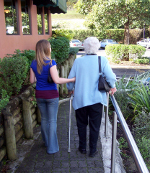Understanding and Evaluating the Abilities of a Senior
Published by Stephen on December 5, 2009 Under fall prevention Seniors often have difficulty safely using the stairs. There are a umber of factors that can cause this and in most cases, it is not one single disease or conditions, but rather a combination of factors that make it unsafe to use the stairs.
Seniors often have difficulty safely using the stairs. There are a umber of factors that can cause this and in most cases, it is not one single disease or conditions, but rather a combination of factors that make it unsafe to use the stairs.
For example, arthritis is very common among the elderly and is a disease that causes joint pain and inflammation. In someone with arthritis, bending the affected joints can be very painful. Often, those who have arthritis will also have osteoporosis and limited vision. Osteoporosis, is a disease that makes the bones more brittle and even though it does not actually cause mobility problems itself, even a short fall will often cause a broken bone. In this case, the senior has several factors that work together, not only making the stairs more difficult to use, but also making falls considerably more dangerous.
What is important to remember is that seniors are usually at a point in their lives where they are not able to heal as quickly and easily as they once were. This means that any injury, even very small ones, can have an effect that extends throughout all aspects of a seniors life. In fact, a recent study actually found that in seniors who have broken a hip, there is a much larger chance that they will have to move to an assisted living facility and the risk of dying is also significantly increased. This helps to show how important it is to prevent these types of accidents from occurring in the first place, because the alternative of post-accident treatment is nowhere near as effective as pre-accident treatment.
Start with the Staircase
As a result of these types of dangers, creating an environment where the senior can safely use the staircase is extremely important. Usually, this starts with evaluating the safety of the staircase, with the condition of the stairs and the presence of safety aids very important.
For instance, ensuring that each of the steps on the staircase is in good repair and not loose is extremely important. It is also important that there is at least one handrail that is at the right height and size for the senior to use. The handrail should be smooth to the touch, so as not to cause abrasions when used, as well as being easy for the senior to grasp completely with their hand. In recent studies, having two handrails, with one on either side of the staircase, has been shown to dramatically reduce the risk of injury.
Another important factor is having adequate lighting on the staircase. However, lighting alone is not enough and it must be possible for the senior to easily operate the lights from both sides of the staircase. This is to say, that it is important for there to be a light switch at the top of the staircase, as well as the bottom, ensuring that the senior will never be put in a situation where they need to use the stairs in the dark.
Next, Take into Account the Senior
While ensuring that the stairway is in excellent repair is very important, it is also essential to observe how the senior interacts with the staircase to determine other risks. This of course includes their actual ability to use the staircase, but other habits should be taken into account.
For example, it may be that for years the senior has set their purse down on the staircase as soon as they come home. In any home, especially one with children, this can cause problems, but among the elderly, having objects on the stairs can greatly increase the risk of a fall.
So, by observing how the senior makes use the stairs and the ease at which they do it, you, as a caregiver, will be better suited to spot and correct problems. In some cases, this could mean installing something like a stair lift, which carries the senior up the stairs, but it could just as easily mean that perhaps the senior should not be using the stairs at all. Understanding this and honestly evaluating the senior is very important.
It is easy to let your love for someone overcloud their inabilities, but in the case of things like using the stairs, this can be very dangerous.
No Comments |
Add a Comment